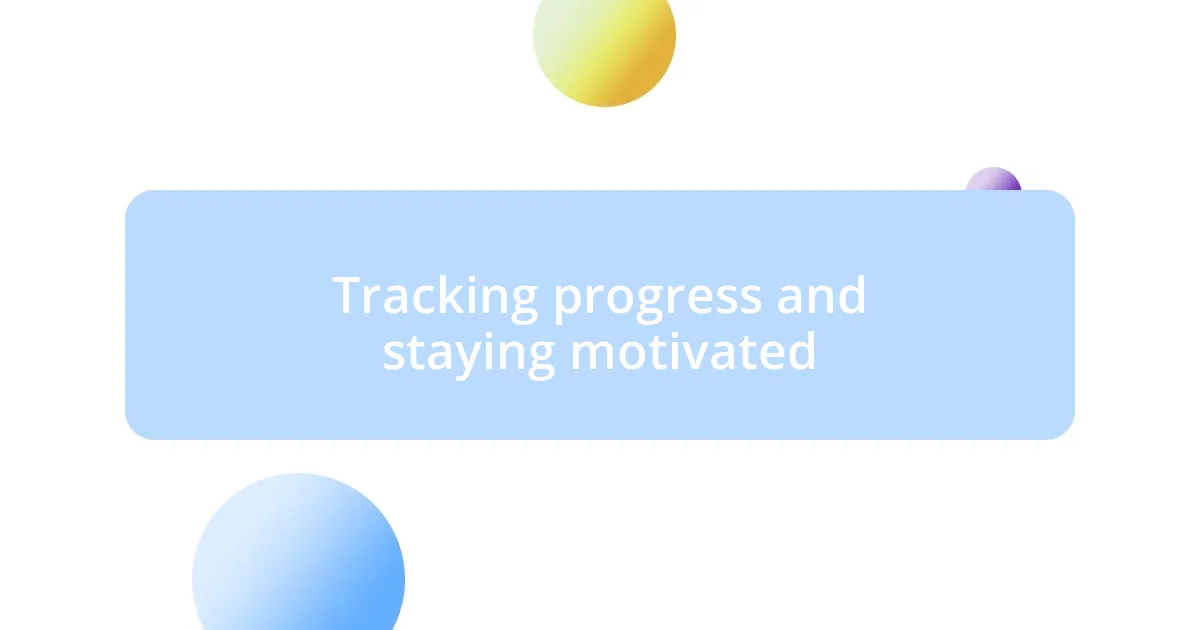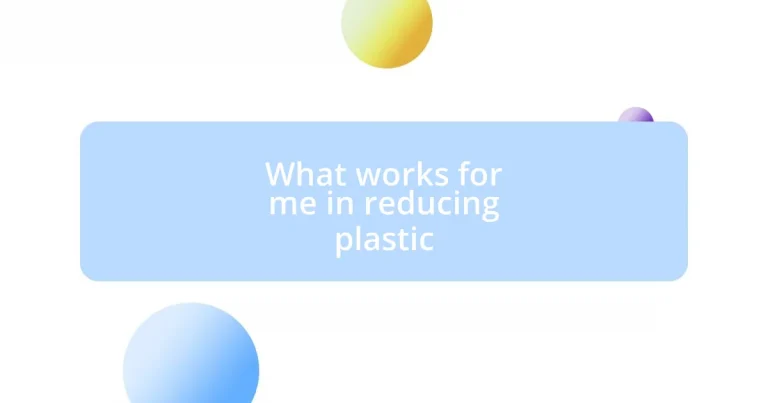Key takeaways:
- Plastic pollution is a significant threat to ecosystems, with many everyday items contributing to a long-lasting environmental impact.
- Identifying personal sources of plastic use can lead to conscious choices, such as using reusable bags and containers.
- Building a sustainable shopping list with eco-friendly options empowers consumers and supports local economies.
- Engaging in community initiatives and tracking progress can foster motivation and enhance the impact of personal efforts to reduce plastic waste.

Understanding plastic pollution
Plastic pollution is an overwhelming issue that goes beyond just littering our streets or clogging up our oceans. I remember walking along a beach one day and being dismayed by the sight of plastic bottles and bags tangled in seaweed. It struck me then how this pollution not only harms marine life but also affects the ecosystems we rely on for clean air and water.
Have you ever thought about the lifespan of plastic? Most products we use daily can last hundreds of years in the environment. I find it mind-boggling to realize that the very items I toss away today will linger long after I’m gone, impacting wildlife and ecosystems. Every time I learn about the effects of plastic on wildlife—like sea turtles mistaking bags for jellyfish—I feel a deep sense of urgency to change my habits.
Understanding the scale of plastic pollution can feel overwhelming, but it’s crucial for motivating change. When I dive into statistics about the millions of tons of plastic entering our oceans each year, it’s hard not to feel anxious. This isn’t just a distant problem; it’s happening in our backyards, affecting places I cherish. How can we ignore this pressing issue when it’s so interconnected with our lives?

Identifying personal plastic sources
Identifying the sources of plastic in our daily lives can be a real eye-opener. I once took a week to track how much plastic I was using, and the results were astonishing. It struck me that many everyday items, like packaging and single-use products, contribute significantly to the plastic footprint I wasn’t even aware of.
Here are some common personal plastic sources to consider:
- Food packaging: Think about the myriad of plastic containers, wrappers, and bags that come with your groceries.
- Personal care products: Many shampoos, conditioners, and lotions contain microplastics or come in plastic bottles.
- Household items: Cleaning supplies and kitchen utensils often come in plastic materials that can easily pile up over time.
- Drinks: Single-use plastic bottles and coffee cups have become an accepted norm, but they add up quickly.
- Shopping habits: I realized that not bringing my reusable bags led to many unplanned plastic bag grabs on shopping trips.
This self-reflection on my plastic consumption moved me to seek alternatives that fit into my lifestyle. Each item I identified became a motivation to make conscious choices moving forward.

Simple swaps for everyday items
When I started seeking out alternatives, I was surprised by how many simple swaps could dramatically reduce my plastic usage. For instance, replacing plastic water bottles with a reusable one not only saves money but also brings peace of mind, knowing I’m not contributing to the plastic crisis. I carry my stainless steel bottle everywhere, and it’s become a part of my daily routine—filled up at home, or during outings, it’s a small change that has a big impact.
Another easy switch I made was to swap plastic food storage containers for glass or stainless steel ones. Initially, I was hesitant about the cost, but I’ve found that they keep food fresher and are much healthier—no worrying about chemicals leaching into my meals. Each time I open my fridge and see those colorful, reusable containers, I feel a sense of pride in my choices, reminding me of my commitment to reducing plastic waste.
Additionally, I’ve tackled the issue of shopping by bringing my own produce bags to the grocery store. At first, I felt a hint of awkwardness, but I soon noticed many stores are now encouraging this behavior. It’s been refreshing to see others follow suit. I remember a moment when a cashier complimented my reusable produce bags; it felt validating and reinforced my belief that small actions can inspire others to join in.
| Everyday Item | Plastic Option | Simple Swap |
|---|---|---|
| Water Bottles | Single-use plastic bottles | Reusable stainless steel bottle |
| Food Storage | Plastic containers | Glass or stainless steel containers |
| Produce Bags | Plastic bags | Reusable fabric produce bags |

Building a sustainable shopping list
Building a sustainable shopping list starts with mindful choices that reflect our commitment to reducing plastic. I remember the first time I sat down to create my own list—armed with information about sustainable products. It felt empowering to choose brands that prioritize eco-friendly packaging. The excitement of discovering items that not only met my needs but also aligned with my values was a real game-changer.
One notable shift I made was incorporating local produce and bulk shopping into my routine. I still recall the thrill of visiting a local farmer’s market, wandering through stalls without the plastic-wrapped produce I was so accustomed to. Each colorful option brought a wave of satisfaction, knowing I was not only supporting local farmers but also avoiding unnecessary plastic. Have you ever thought about how much fresher food tastes when free from packaging? Trust me, it’s a noticeable difference that adds an extra layer of joy to your meals.
Finally, I found joy in digital grocery lists that included eco-conscious items. I began by marking brands that stood out in their commitment to sustainability. By having a curated list, I noticed my trips to the store became much more intentional. The thrill of checking off items that reflected my values felt incredibly satisfying. Have you ever considered how a little preparation can make such a profound impact on our planet? It’s this kind of proactive approach that fuels my passion for sustainable living.

Effective waste reduction strategies
One waste reduction strategy I’ve embraced is composting. I remember the first time I started a small compost bin in my kitchen; it felt like turning waste into something valuable. Every vegetable peel and coffee ground felt like a new opportunity to give back to the earth instead of just filling up landfills. Have you ever considered how much organic waste you throw away? It’s astounding how easy it is to repurpose that waste into nutrient-rich soil for gardening.
Another impactful method has been engaging in the concept of ‘buying less.’ In the past, I’d often purchase items I didn’t really need—only to have them languish unused. Now, I consciously ask myself if each purchase aligns with my values and needs. I can’t tell you how liberating it is to resist impulse buying. It’s like a breath of fresh air when you simplify your possessions. How often do we think about the environmental cost behind each item we bring home?
Lastly, I’ve found that participating in community clean-up events has not only helped reduce waste but also fostered connections with like-minded individuals. The first time I picked up garbage off a local beach, I was surprised by how fulfilling the experience was. It wasn’t just about cleaning up; it was witnessing the power of community action. Have you ever joined a group dedicated to environmental change? The camaraderie and shared purpose made me feel part of something bigger—a collective effort to protect our planet.

Engaging community initiatives
Engaging in community initiatives has been one of the most fulfilling parts of my journey toward reducing plastic. I still remember the first time I volunteered for a local recycling project. It was eye-opening to see just how much plastic waste our community generates. As I sorted through the items, I couldn’t help but think about how many of those could have been avoided with better habits. Have you ever stopped to consider the impact of collective efforts?
I’ve also participated in neighborhood workshops focused on sustainable living. One remarkable session involved crafting reusable bags from old T-shirts. I remember the pride I felt holding up my creation, transformed from something destined for the trash into a functional item that I could use daily. Not only did I gain a practical tool, but I also connected with others who shared the same passion for sustainability. It made me realize that working together amplifies our impact. Isn’t it incredible how shared experiences can turn into actionable change?
Additionally, I’ve seen the power of local campaigns advocating for plastic bans. A few months ago, I joined a rally that called for our town to eliminate single-use plastics. The energy and determination in that crowd were palpable. As we marched, I felt a deep sense of purpose, knowing that we were united in a cause that matters not just to us but to future generations. Have you ever felt that sense of urgency to stand up for something you believe in? It’s a truly invigorating experience that fuels my commitment to a plastic-free lifestyle.

Tracking progress and staying motivated
Tracking my progress in reducing plastic has been a real game changer for me. I’ve started using apps to log my plastic-free days, and the satisfaction of seeing those numbers grow motivates me more than I expected. It’s like a countdown to a personal goal—each day feels like a small victory that keeps me inspired. Have you ever tracked a habit and felt that rush of accomplishment when you see progress?
Beyond numbers, I keep a journal to reflect on my experiences. I write about the challenges I face—those moments at the store when temptation strikes—and how I overcome them. Revisiting these entries has helped me realize how far I’ve come. Those reflections often spark new ideas on how to tackle future hurdles. Isn’t it amazing how putting pen to paper can transform thoughts into actionable strategies?
To maintain motivation over time, I love setting small challenges for myself, like plastic-free weeks or trying out zero-waste recipes. There’s something thrilling about pushing my boundaries and sharing my journey with friends. When I share my successes, it also encourages them to join in, creating a little community of support. Have you thought about how sharing your goals could amplify your efforts?












